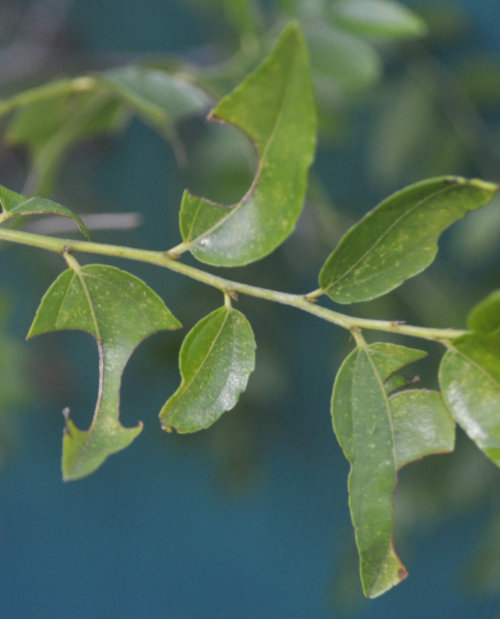Leafcutter Bees
Have you ever seen these very smooth round and oval shapes in leaves before, and not known what made them?

© Optimate Group Pty Ltd
These aren’t caused by caterpillars, which produce jagged edges. These very smooth edges are the tell-tale sign (to those in the know!) of leafcutter bees. And if it weren’t for jujube trees and one particular book, I may never have known of their existence or that we even had them here!
Watch one in action:
The bees use these cuttings to make a brood cell for their young, which is the cutest thing!
For years I had noticed these intriguing holes in leaves, but only on Ziziphus leaves, and on young rootstock leaves especially. It was somewhat weird, but apart from trivial cosmetic damage, no other harm was evident and I never really thought much about their origin.
Last year I looked into native honey bees, with the intent of setting up a hive or six — they’re native, stingless, make honey, are pollinators — what could go wrong?! Sadly, all too good to be true, as we are at the extreme southernmost edge of their range and the bees struggle in our temperate winters. Even if we had an acclimated hive, they’re barely able to produce enough honey to get themselves through winter let alone anyone else. So that idea went on the backburner, though I’m always on the lookout for a local colony that may wish to relocate!
I do highly recommend this beautiful book if anyone is interested in investigating native bee hives for themselves, or just wants to learn more about Australian bees in general.
But anyway, it was from that book that I learnt of the existence of leafcutter bees. There, on page 15, a photo of those very distinctive leaf cut-outs leapt right out at me, and I couldn’t get outside fast enough to confirm if the holes I’d noticed where the very same ones (they were).
Origin now known!
As I said, these bees really like the small leaves of Ziziphus rootstock, and I don’t have to look too hard to find evidence of this everywhere! Particular plants seem especially attractive to them, and multiple leaves on multiple branches are riddled with holes, while their neighbours go mostly untouched.
Australian leafcutter bee species range from 6 – 15 mm, and maybe the species that visit are towards the smaller end of the scale if it’s these small and tender leaves they favour. Certainly finding evidence of leafcutter bee activity on the larger, thicker leaves of jujube trees was much harder, but I found this Chico leaf:

© Optimate Group Pty Ltd
and the missing segment on this Suimen leaf appears to be a conglomerate of several holes, as in the video above:

© Optimate Group Pty Ltd
If so, there must be something about this leaf for multiple bees to go for it, and only it, while leaving its neighbours alone!
Apparently these bees have a liking for rose leaves too. And yes, once I found a rose bush, the signs weren’t hard to find at all:

© Optimate Group Pty Ltd
Another favoured plant is Wisteria, so it’s guaranteed that I’ll be checking the first one I discover when out and about for those smooth-edged holes!
Unlike native stingless bees, leafcutter bees are found all over Australia, and across a range of climates and habitats. While not everyone is fortunate to have native stingless bees in their area, there is a good chance that at least one species of leafcutter bee will exist, and make its presence known with those delightfully symmetrical holes!
About the Author
BSc(Hons), U.Syd. - double major in biochemistry and microbiology, with honours in microbiology
PhD, U.Syd - soil microbiology
Stumbled into IT and publishing of all things.
Discovered jujube trees and realised that perhaps I should have been an agronomist...
So I combined all the above passions and interests into this website and its blog and manuals, on which I write about botany, soil chemistry, soil microbiology and biochemistry - and yes, jujubes too!
Please help me buy a plant if you found this article interesting or useful!